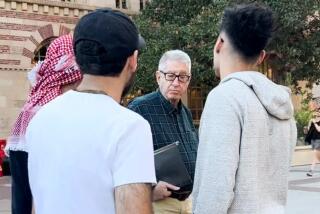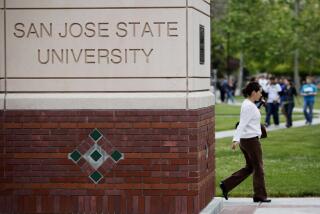Helping His Students Find Their Voices
- Share via
Professor Louis Sarracino’s voice will finally have a chance to rest.
His throat battered by 55 years of easing college students’ stage fright, the speech teacher has sucked almost constantly on herbal cough drops.
Sarracino, 80, is retiring from East Los Angeles College at the end of this semester, after a career so long that he has taught grandchildren of his first students.
Although his workload has shriveled to two courses this semester from seven at its peak, Sarracino still heads his classes with a patience and humor that encourages public speaking, whether for recent immigrants, shy women just out of their teens or men scared to talk about their feelings.
“I’ve enjoyed thoroughly being part of the process of making some of my students better people,” said Sarracino, who lives with his wife in Huntington Beach. “But I’ve been at it long enough.”
He began one of his last classes the same way he started some of his first: screaming and gesturing as he quoted from “Cyrano de Bergerac” in an exercise to help reduce students’ jitters.
As Sarracino’s students mimicked his actions, some halfheartedly and others with movements as sweeping as his, their voices filled the muggy bungalow and streamed out its windows.
Dapper in a red gingham shirt and khakis with shoes and belt of mahogany leather, Sarracino ambled around the classroom to prompt some of the more self-conscious students to participate.
A dozen students then took turns speaking in front of the class, on topics that included singing lessons in Macedonia, making quesadillas and condom use with a cucumber prop.
“There’s no holds barred in his class,” said current student Michael Gomez, 28, of Maywood, who gave a speech about his “homegirl” friends. “It’s as uncensored of a college experience as you’ll find anywhere. He lets people really explore things about life that other professors wouldn’t let us talk about.”
Many of Sarracino’s current and former students, including Gomez, said his teaching has inspired them to enter teaching or communication careers.
Yesmean Rihbany, who took classes from Sarracino in the 1970s and taught communication herself at the high school and university level, said the professor’s unconventional teaching created a safe learning environment.
“He put the idea of grades off to the side and taught us to challenge other people’s ideas,” said Rihbany, 48, of Long Beach, who is now a corporate speech trainer.
“I had terrible stage fright when I entered his class and no thought whatsoever of going into speech communication. But Louie is one of those people who changes the course of your life.”
College administrators have also noticed Sarracino’s effect on his students. Ernest H. Moreno, who has been president of East Los Angeles College for nine years, called Sarracino “an institution.” The school does not keep records about longevity of service, but Sarracino clearly is among its most veteran professors, the president said.
“He teaches one of those classes that people usually put off as long as possible,” Moreno said. “But you can’t ignore the long lines to enroll in his classes every semester. What he does with his teaching is really magical.”
Moreno and other officials honored Sarracino last week with speeches and a plaque at a ceremony following his last class.
Sarracino almost didn’t finish college himself. A poor Italian boy who grew up in East Los Angeles and started at Los Angeles City College thinking Aristotle was a kind of cocktail, he felt out of step with more affluent students. He stayed in college only at the insistence of one of his professors.
After receiving a bachelor’s degree from Cal State L.A., he spent World War II stationed in Texas, where he helped soldiers returning from combat deal with their psychological scars. He later received advanced degrees in speech and communication from UC Santa Barbara and USC before starting to teach at the college level.
A former Fulbright scholar who taught in Iraq and the Netherlands, Sarracino has spent nearly all of his career at the Monterey Park campus.
Sarracino said he never wanted to publish or scuffle for tenure at a large university, adding that working at a community college allowed him to employ innovative teaching methods and worry less about being politically correct.
He never fails students who take his class, a college graduation requirement. Sarracino tells students to withdraw if their grades are low and he calls those with many absences to urge them to attend.
“All that crazy pressure they’re relieved of goes into writing their speeches and delivering them,” said Sarracino, who requires eight speeches from his students during a semester.
“I’m just here to reduce their stage fright and make them think. I don’t get any kick out of hurting people who’ve already overcome so many obstacles to get to college in the first place.”
Since Sarracino has been teaching only one day a week, he has had the rest of his days free to learn bridge, latch-hook a portrait of Egyptian Queen Nefertiti and play dodge ball and “school” with his three grandchildren.
Fiddling with a beige baseball cap from his granddaughters that reads “No. 1 Papa,” Sarracino eagerly shows visitors pictures of them and his three sons, who work in the entertainment industry.
Sarracino flits from subject to subject, talking in the same breath about the importance of living creatures--he’d drive a black widow spider to an uninhabited area rather than kill it--and his garden of broccoli and cabbage.
But when he’s in the classroom, Sarracino’s attention is on his students: nodding, exclaiming and murmuring praise as they speak.
When Dimitar Zlatev, 56, launched into a tender rendition of “O Sole Mio” after a speech on learning to sing as a young man in Macedonia, Sarracino’s expression turned dreamy as he listened.
“Students just don’t worry about being embarrassed in his class,” said Zlatev, who moved to Whittier from Macedonia in 1989. “He helps us feel free to experiment instead of pushing too hard for us to memorize facts or read books.”
Bonding with his students is important for Sarracino, whose Rolodex bulges with the names and addresses of former students from the 1950s through last year. In lieu of a final, Sarracino takes his students to dinner, which he will do for the last time this week.
“Teaching is an inner connection between yourself and your students that really nurtures both people,” Sarracino said. “They pay me to get rid of stage fright, but my true compensation is the friends I’ve made in my students.”
More to Read
Sign up for Essential California
The most important California stories and recommendations in your inbox every morning.
You may occasionally receive promotional content from the Los Angeles Times.













